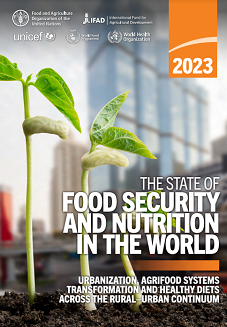SDG monitoring
The FIES in the context of the Sustainable Development Agenda
The measure of food insecurity based on the FIES complements FAO’s traditional indicator of hunger, the Prevalence of Undernourishment - PoU (SDG indicator 2.1.1). Based on different sources of data and methodologies, these indicators offer two different approaches to measure progress towards achieving Sustainable Development Goal 2: End hunger, achieve food security and improved nutrition and promote sustainable agriculture. The PoU helps to measure progress towards the target of ending hunger, while the FIES-based indicator helps to measure progress towards the target of ensuring access to food for all.
The 2030 Agenda, by including the FIES-based indicator in the global SDG monitoring framework, recognizes that food insecurity is more than hunger. The Zero Hunger goal aims not simply to “eradicate hunger”, but also to “ensure access by all people […] to safe, nutritious and sufficient food all year round” (SDG Target 2.1) and to “eradicate all forms of malnutrition” (SDG Target 2.2). FIES-based indicators will serve to track global, regional and national changes in food insecurity, providing information for international and national-level policy making.
Interpreting FIES-based indicators
Two FIES-based indicators can be used for national and global monitoring purposes. Note that the first indicator is an estimate of the sum of the moderately food insecure and the severely food insecure segments of the population.
FImod+sev The proportion of the population experiencing moderate to severe food insecurity
FIsev The proportion of the population experiencing severe food insecurity
People experiencing moderate levels of food insecurity will typically eat low quality diets and might have been forced, at times during the year, to also reduce the quantity of food they would normally eat, while those experiencing severe levels would have gone for entire days without eating, due to lack of money or other resources to obtain food. We expect the prevalence of severe food insecurity to be highly correlated, across countries, with the Prevalence of Undernourishment.
The State of Food Security and Nutrition in the World is the most authoritative global study tracking progress towards ending hunger and malnutrition. It is produced jointly by FAO), the International Fund for Agricultural Development (IFAD), the United Nations Children's Fund (UNICEF, the UN World Food Programme (WFP) and the World Health Organization (WHO).
The report provides the most up-to-date food security and nutrition indicators, with a focus on those that relate to SDG 2, “End hunger and achieve food security and improved nutrition”. This includes yearly estimates of the prevalence of moderate or severe food insecurity based on the FIES (SDG indicator 2.1.2) at global, regional, sub-regional and country levels.

- Interpreting FIES indicators

